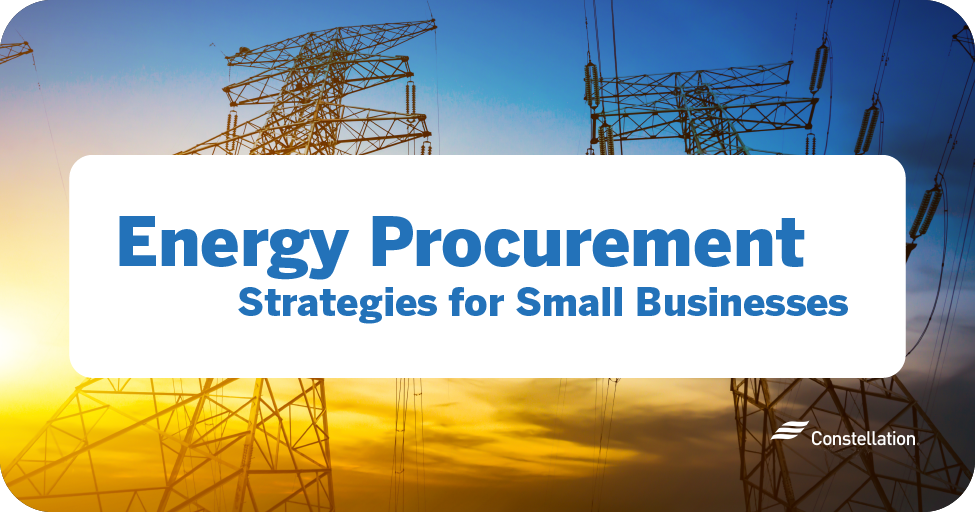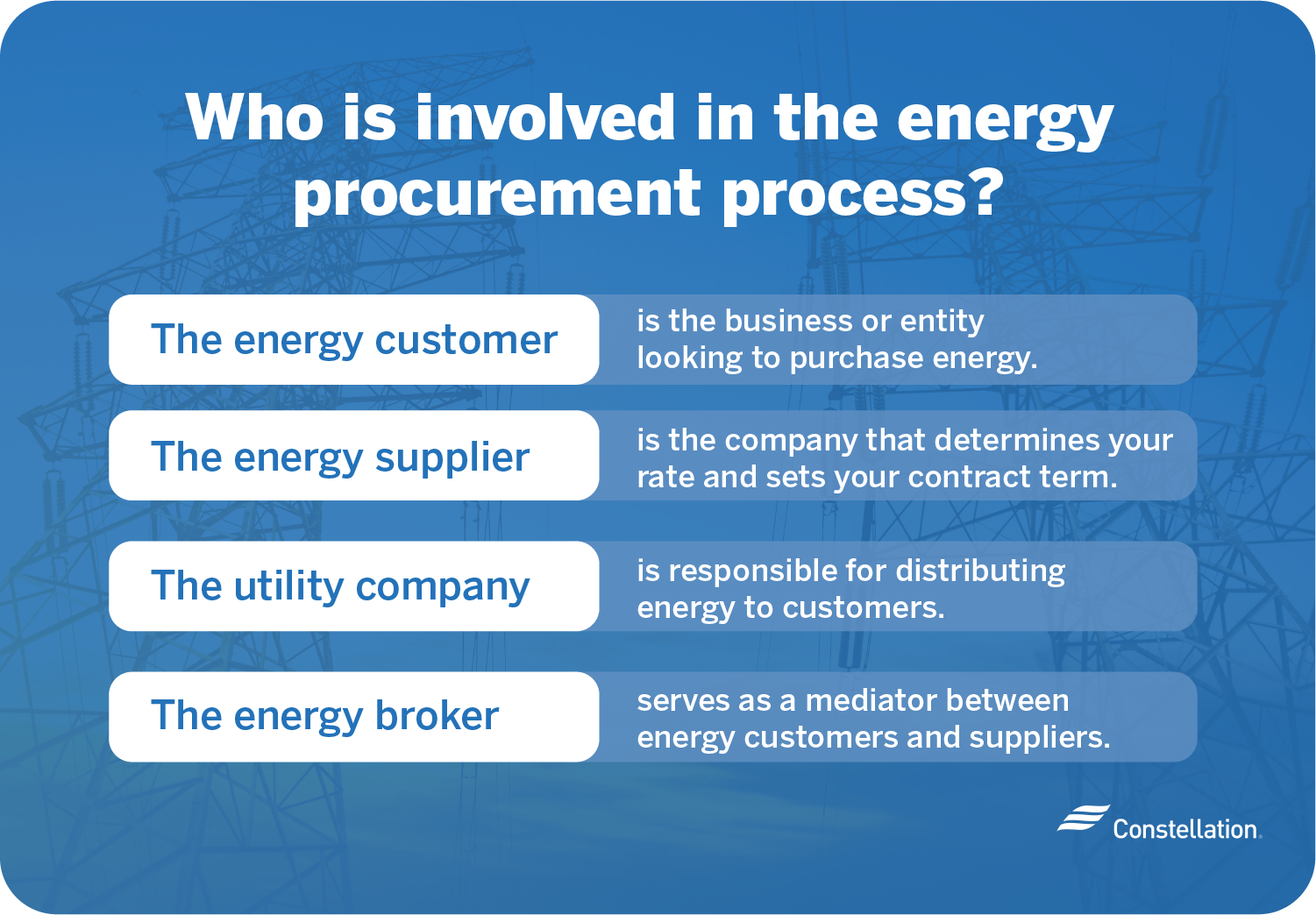
- Category:
Energy Choice -
Last updated:
February 22, 2022
Energy Procurement Strategies for Small Businesses
When it comes to choosing an energy contract, small-business owners have a lot to consider. And without performing the proper research, the whole process can start to feel overwhelming. That’s why it’s good to have a small-business energy purchasing strategy in place.
By understanding energy procurement, as well as the types of energy contracts available, you can develop a strategy that allows you to take greater control over your business’s energy consumption and limit your overall expenses.
Understanding small-business energy procurement
Energy procurement is the process of obtaining the fuel or electricity that powers your business. It entails working with energy suppliers and utilities to find an energy contract that best suits your particular business’s needs. To make the most of your small-business energy purchasing strategy, it helps to shop around and compare your options until you find the service you need at a suitable price.
Some states are turning to energy deregulation as a way to give energy customers more say over where and how they get their energy. In a deregulated market, customers are allowed to choose their energy providers and plans, which helps to keep energy prices low while also preventing monopolies and increasing competition among suppliers.
Do all small businesses need an energy procurement strategy?
Regardless of how much energy your small business uses, an energy purchasing strategy can help you minimize overhead energy costs and improve your overall energy efficiency. The following are some of the many types of small businesses that can benefit from having an energy procurement strategy:
- Restaurants
- Warehouses
- Retailers
- Manufacturers
- Construction companies
Who is involved in the energy procurement process?
Depending on the situation, there are several parties who may get involved in the commercial energy procurement process:

- The energy customer. The customer is the business or entity looking to purchase energy. Though not always necessary, some businesses — such as those with high overhead energy costs — may decide to hire someone specifically for the purpose of developing cost-saving energy procurement strategies.
- The energy supplier. Energy providers, or suppliers, are the retail energy companies that determine your rate and set your contract term. When choosing an energy supplier, it’s important to compare your options until you find a plan that’s right for your business.
- The utility company. Utility companies are responsible for distributing energy to customers as well as servicing outages and emergencies. Some utilities generate the electricity they deliver, while others purchase it from third-party vendors, such as other utilities or independent power producers.
- The energy broker. Energy brokers serve as go-betweens for energy customers and producers. They’ll work to understand your small business’s needs and objectives in order to match you with the best supplier.
The different types of energy contracts for your small business
There’s a lot that goes into choosing the right energy plan. A small-business energy purchasing strategy can make the process easier, helping you to outline your needs and identify potential ways to save money. The best type of energy contract for your business will depend on several factors, such as how your business uses energy and how much risk you’re willing to take.
Fixed rate
Fixed-rate contracts allow you to secure one set energy rate over a period of time, say two years. When you set a fixed rate, it remains the same regardless of how market prices shift. Although your bill will still depend on how much energy you use in a given month, choosing fixed contracts as your energy procurement strategy offers the benefit of stable rates and more consistency in your energy expenses.
Fixed-price layered strategies
You may also have the option to use a fixed-price layered strategy when purchasing energy for your small business. With this approach, you can buy your energy in “layers” over time. For example, you may decide to purchase 25% of your load every six months over a two-year contract.
A strategy like this can help you hedge the timing risks of locking in a rate over a longer period of time, and possibly save you money. But you’ll still get the stability and predictability of a fixed plan.
Variable rate
In a variable-rate contract, the rate you pay for energy changes month to month with the market. When comparing variable vs. fixed energy plans, variable plans offer more freedom to change suppliers and increased savings when market prices are down.
But these energy contracts come with more risk. You’ll be subject to unexpected changes in your rate from bill to bill and possibly pay more for energy when market prices go up.
Indexed pricing
With indexed energy contracts, your rate is directly determined by market conditions. Indexed contracts are 0% fixed, meaning that your price per load is constantly changing as market prices rise and fall. Since they’re so dependent on external factors, indexed contracts are considered one of the riskier energy procurement strategies. However, they can also yield big savings, if done correctly.
Blended
Blended or layered energy contracts can be an effective small-business energy purchasing strategy. A blended contract allows you to combine aspects of both variable and fixed plans in order to get the most out of your energy budget.
There are various ways you can “blend” your contract, but the best approach will depend on your particular business’s needs and risk tolerance. For example, you may decide to do a 50-50 blend on your energy contract. This means that 50% of the energy you use will be charged at a fixed rate, while the other 50% will be charged at the indexed rate. Or if you’re open to playing the market, you could do something like a 70-30 blend, where 70% of your energy is tied to the index.
Regardless of the blend you choose, the goal of a blended contract is to give you some consistency in your energy bill while also allowing you to benefit from price drops.
Questions to ask when purchasing energy for your business
When purchasing energy for your small business, it’s important to consider how your business operates and uses energy. For example, you’ll want to ask yourself the following questions:
- Which type of fuel does my business need?
- How much energy does my business usually use?
- What’s my business’s energy budget?
- What’s my ideal contract term length?
- What are my business’s priorities and objectives?
- What are the current market energy rates?
- How much risk am I willing to take?
The benefits of energy procurement plans
There are several ways businesses can benefit from using energy procurement strategies:
- More control over your plan. A commercial energy procurement strategy can help you take greater control over things like your fuel costs, contract term and billing schedules.
- Greater reliability. With the right energy procurement strategy, you can minimize financial risk and have a more predictable, consistent energy bill each month.
- Added convenience. Developing a strategy for how and where you’ll get the energy to power your business can make the purchasing process quicker and more convenient.
- Potential energy savings. By taking control over the energy procurement process, you may be able to secure lower rates and reduce your small business’s energy costs.
Determining the right energy purchasing strategy for your small business
If you’re unsatisfied with the service you’re receiving or the amount you’re paying for energy each month, you may want to rethink your energy purchasing strategy. Taking some time to explore the different small-business energy options available to you will help ensure that you get the rates and service you need to keep your business running smoothly.




